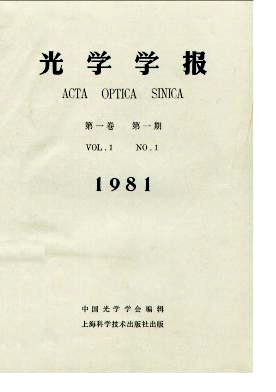
The change mechanism of optical constants of glasses under the action of thermal, stress, acoustic and electric fields is analysed on the basis of the dispersion theory. The change rules of temperature coefficient of refractive index, photo-elastic constant, stress-optic constant, thermo-optic constant and nonlinear refractive index of glasses and the relationship between these properties and chemical composition and structure of glasses are presented. The calculating methods of above properties have been developed by present work. The intense laser induced thermal blooming, self-focusing and damage in glass are discussed in terms of nonlinear change of refractive index of glasses.
A computer program describing the diffraotional transmission of a light beam (paraxial) was formed based on the hydrodynamio model of field.
Some characteristics of optioal resonators are analysed in the theory of transform matrix, and it is pointed out that there are two kinds of eigen state in resonators, that is, "point beams"and"Gauss beams".
Noisy images with a periodic structure can be cleared by utilizing optical periodic average method. In this paper the higher signal-to-noise ratio obtained by this processing method was discussed, the experimental apparatus was improved, the specific pattern of filter used in the coherent optical system and the experimental results were given.
In this article, principles of two new mechanisms for producing usual aspherical surfaces are proposed. The geometrical relationships are discussed. As a special feature of this method, the grinding instrument is always in line contact with the work piece during grinding and continuity of produced surface will be expected.
The four diffraction grating ruling engines developed in Changchun Institute of Optics and Fine Mechanics are described. The design of the 1st engine started in 1958. The 1st and 2nd engines are mechanical engines. They were built up at 1959 and 1965 respectively. The 3rd and 4th engines are photoelectrically controlled engines. They were built up in 1970 and 1975 respectively. Each engine has its special constructional features. The 4th engine has phase look error of about 1/100 fringe in average in the case of continuous carriage motion and 1/36 fringe in maxinmm. Many plane diffraction gratings have been produced from these engines. The maximum ruling width is 185 mm among these gratings. The ruling density is from 60 l/mm to 1200 l/mm. Practical resolving power is up to 200,000, relative efficiency up to 90%, relative intensity of Rowland ghost down to 4×lO-5 in 1st order. Lyman ghost is not observable.
In this paper we discussed the possibility of using a suitable pupil function lo compensate the aberrations of optical system. The question is just as a functional minimization problem in Hilbert space. The general form of the solution minimizing the wave variance is obtained, especially the effect of using a ring phase pupil filter to compensate the symmetrical aberrations is studied. The parameters of filter is determined with the S. D as a criterion. Several cases are discussed and compared in terms of MTF.
The layout design of optical instruments is a subject under development. In this paper some basic problems are put forward and discussed: 1. functional research of the instrument as a member of the global system; 2. analysis of performance-construction relationships; 3. optimising the general constructional parameters; 4. engineering coordination among subsystems. It is noted that there is mathematical similarity in the losses and gains of information during transferring and transforming processes via optical, mechanical or electronic parts of the instrument, and therefore they oan be treated with a common mathematical approach, The introduction of concepts of system engineering and information theory to the discussion of these general problems is found beneficial to the insight into the subject. In addition, a few remarks are made to the conditions, namely, the basiC experimental data and the mathemattical models, that should be provided for the prospective practice of computer-aided-layout design.
A Fourier transform lens of the doublet type with small air separation is described. The anomalous combination of glasses is used to reduce the Petzval sum, while a proper amount of spherical aberration and coma is held to control the astigmatism. The image quality is diffraction limited in both input and frequency planes at f/10.
The guided-wave electro-optic prism has been fabricated by the process of photolithography on a Ti-diffused LiNbO3 waveguide. When it is used as an intensity modulator, the driving voltage is ±19V for 100% modulation depth, the fundmental bandwidth is 1.5GHz,and the driving power per unit bandwidth is 9.5mw/MHz. When it is used as a bipolar switch, the switching voltage is ±19V, and the switching time is 0.1ns.
In this paper, the state of the art and the outline of optics and applied optics in China including lasers, infrared and opto-eleotronieal techniques, fundamental optics, and fundamentals of technical optics and optical techniques are reviewed. The issues for further development of optics and applied optics in China are proposed.
We will describe a technique of white light optical information processing with diffraction grating method and some of their applications. This white light technique enables the signal processing to be carried out in complex amplitude rather than in intensity. The basic advantage of this white light processing technique is the elimination of the coherent artifact noise that frequently plagues the coherent optical system. We note that this white light processing technique is capable of processing many complex signals that a coherent prooessor may offer. The applioation may range from complex signals that a coherent prooessor may offer. The application may range from complex signal addition, subtraction, to complicated optical parallel processing. Because of the use of spectral broadband light source, this technique is very suitabla for color-image processing, enhancement, and restoration. Experimental demonstrations of this white-light processing technique as applied to archival storage of color films, multi-image rageneration, spatial frequermy and density pseudocolor encoding, smeared image restoration, etc. will be included.










